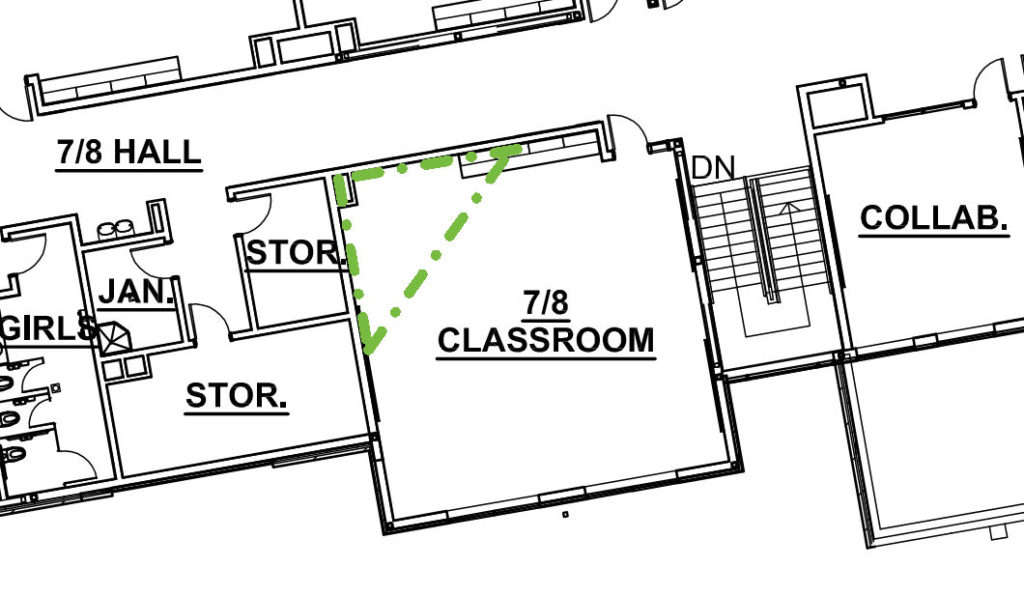When I watched the video animation of the Parkland shooting months ago, I could not understand why students were “hiding” in the line of fire – directly in front of the classroom doors. While it’s possible that for some of the classrooms there was no time for students to move to a safer location within the room, the Florida commission investigating the shooting has identified a problem with the lockdown planning.
As reported in the Sun Sentinel:
Security experts on two separate occasions in the past two years advised teachers and administrators to mark safe areas called “hard corners” in each classroom, said Pinellas County Sheriff’s Detective Walter Bonasoro, serving as an investigator for the commission.
 These are areas located at an angle that would prevent anyone firing a gun through the classroom door from hitting anyone in them.
These are areas located at an angle that would prevent anyone firing a gun through the classroom door from hitting anyone in them.
But just two teachers in Building 12, where the shooting took place, marked off hard corners, using tape, and these had too much furniture and other materials for all students to be able to crowd into them during the shooting.
Unfortunately, some classrooms are designed with so much glass that it is almost impossible to create a hard corner without relying on furniture, but in many classrooms it would cost little or no money to indicate an area where kids should go during a lockdown drill or an actual incident. Of course, the classroom door must be locked in order for hard corners to be effective.
Are these safe areas identified in the schools that you work with or visit?
On a related note, I just read this article on Mother Jones: Here’s What Lockdown Drills are Like for Schoolchildren. Below is the video that accompanies the article. We need to continue to consider the impact of security measures on students. I’m not in any way suggesting that physical security should be abandoned, but the way the message is delivered is important.
You need to login or register to bookmark/favorite this content.






I like that it appears the doors to the classrooms are recessed into the rooms, making for a degree of cover from a shooter in the hallway. Slick wall hallways or those with only lockers between rooms make it easier for a gunman to strike targets without moving.
This concept only works of the corridor walls themselves are bullet proof.
Most (if not all) school walls are susceptible, given the assailant has the proper ammunition.
A secondary means of egress directly to the outside would be the best method for removing students from the situation,
but even that has flaws in certain situations.
Hi Joseph –
If you look at past school shootings, it is not very common for shooters to shoot blindly through walls, but it is common for them to shoot through glazing in windows and doors where they can see people inside of the room. I strongly believe that moving students and teachers out of the line of sight, turning off lights, and waiting silently is a viable option if it is not safe to evacuate.
– Lori
Please don’t misunderstand me, i whole heartedly agree that we should do everything in our power to protect students and removing them from the line of sight is a good thing.
I believe that, as an Architect, we can and should lead the fight to establish design standards that make our schools safe places for students and staff.
It will make school construction more expensive, but how can you put a price tag on a child’s life?
I hear you, and thank you for clarifying. The hard part is knowing where to draw the line. Bullet-resistant doors exist, but are they needed? Feasible? Walls could be reinforced and there is glazing that will help resist gunfire, but how do we know where the money is best spent? And what about all of the existing schools, where making sure the classroom door is lockable and taping off a hard corner is a lot better than nothing?
– Lori
I would note that while most interior walls maybe constructed of simple studs and sheetrock, in schools many are block walls and newer ones likely have two layers of Type X on each surface. Couple that with the fact that when a trajectory is at a sharp angle, there is a much greater chance of hitting a stud, I think there’s great value in just recessing doors the length of the leaf.
Nothing will be perfect, but simple solutions with the least special materials (lower cost) will likely be employed in a larger percentage of projects, as in the end, there is always a risk v. benefit, where the risk = costs and the benefit is the potential reduction in lives lost.